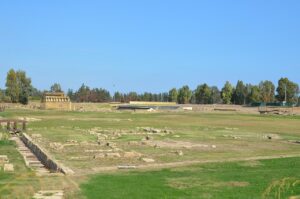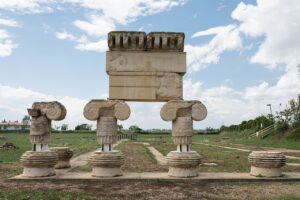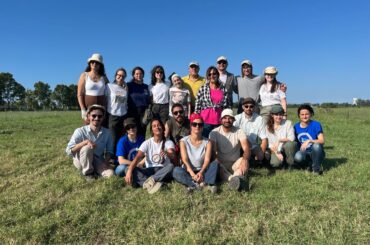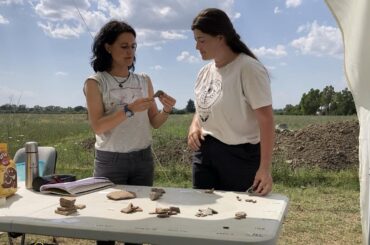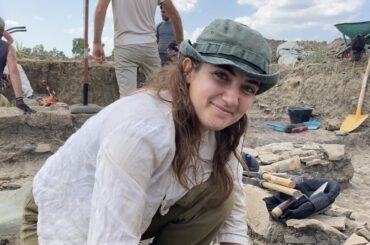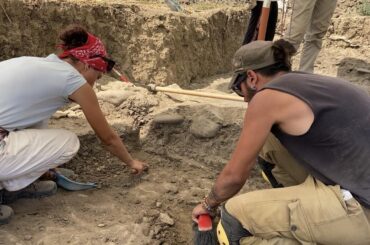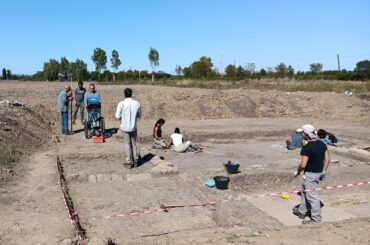Metaponto (2021-)
The apoikia of Metaponto
The ancient city of Metapontum (It. Metaponto), part of ancient Lucania, was located in the eastern part of Southern Italy facing the Gulf of Taranto, in today’s region of Basilicata. It was one of the distinct cities, part of Magna Graecia, with specific archaeological traits. Assumingly, Achaean colonists urged by the neighboring Sybaris in an attempt to dissuade Tara’s expansion, they founded the city of Metaponto in the early 7th BCE. Between 6th and late 5th BCE, the city of Metaponto met its heyday, before its gradual decline since the 4th BCE up until the city’s abandonment by the Carthaginians in the face of Roman retribution during the 3rd BCE.
The apoikia of Metaponto as was placed between the rivers of Bradano and Basento, grew particularly wealthy – cutting its own coinage – due to its prominent position on trading routes that connected the inland Chora with maritime commercial networks; and, more importantly, its fertile and rich countryside which included a plethora of farms. It was in Metaponto that Pythagoras following the destruction of Croton found refuge until his death, as well as Pythagorean philosophy flourished for years since.
Archaeological Context
Archaeological evidence confirms the importance of the city. Adopting since its early days a relatively rectangular urban organization, it consisted of wide streets intersected by narrower alleys (stenopos) thus forming urban squares; the foundation of ceramic workshops giving important findings of red-shaped pottery; and the provision, since the city’s earlier phases, for public spaces, i.e. a religious center consisting of four temples (Temple of Apollo Lykeios, Temple of Hera, various altars and shrines), and public spaces (ekklesiasterion – theatre, agora). Sanctuaries, pottery workshops, residential remains and cemeteries were located in the hinterland of the city, with the Archaic extra-urban sanctuary, probably dedicated to Hera, in the area known as Tavole Palatine, being an important archaeological site of interest.
The wide public spaces of Metaponto have been extensively studied since at least the 1960s. Similar investigations are still being carried out in the city’s countryside (Chora) unearthing significant archaeological evidence and considering the contact between apoikia and local populations; exploring, consequently, the character of the Greek settlement in the area. However, while the religious and public centers have been systematically investigated, the residential sector, although known for its size and its rectangular planning, it remains unknown in terms of residential organization (residential districts), building structure and decoration.
The excavation of residential Metaponto
To this end, this archaeological research aims to determine the urban Metapontian character, the peoples’ daily life and habits within the districts, their artisanal activities and cultural preferences. Therefore, the archaeological research focusing on one of the city’s districts investigates the residential and architectural patterns by which the town was built and developed during the various phases of its long history.
The excavation has been carried out since 2021, with the collaboration of the University of Basilicata and the University of Crete, under the direction of Maria Chiara Monaco (Professor of Classical Archaeology) and Dimitrios Bosnakis (Professor of Classical Archaeology) respectively.
So far, the archaeological research has focused on the residential block south of the temple of Apollo Lykeios, at the junction between the ‘avenue’ and the transverse narrow streets, in Plateia III; specifically, in the eastern part of said residential block. Applying various scientific tools including geomagnetic methods and photogrammetry, a rich settlement complex becomes apparent. So far, the architectural remains of three rooms of a building dating between the late 4th and 1st BCE have been revealed, the walls of which are built of stones in second use and raw bricks, altogether decorated with polychrome mortar and stone cornices in their upper parts. The rooms form an inner courtyard (patio/room 2), in which rich deposits of archaeological material came to light. In the N of the enclosed residential complex, three additional rooms have been traced, probably of supplementary use due to the water collection drainage which was found much lower than the existing strata. The research’s future objectives focus on the clarification of the house plan by extending the excavation to adjacent areas, as well as the understanding of the structure’s chronological evolution by continuing the excavation to lower strata earlier to the 4th BCE terminus.
Bibliography
- Adamesteanu D. (ed.) (1999) Storia della Basilicata, I: L’antichità. Roma-Bari: Laterza.
- Adamesteanu, D., Mertens, D., De Siena, A. (1975) ‘Metaponto, Santuario di Apollo. Tempio D (tempio ionico): rapporto preliminare’. Bollettino d’ Arte, 60, pp. 26-49.
- Adamesteanu, D. (1970) ‘L’agora di Metaponto’. Scritti di archeologia ed arte in onore di C.M. Ledei, Stoccolma, pp. 39-43.
- Bottini, A. (2022) ‘Metaponto e gli indigeni in età arcaica’. Sicilia antiqua : an international journal of archaeology, 19. Pisa & Roma: Serra, pp.17-24.
- Carter, J. C., University of Texas at Austin Institute of Classical Archaeology (2006) The study of ancient territories: chersonesos and metaponto : 2004 annual report. Oxbow: Institute of Classical Archaeology.
- De Siena, A., Cracolici, V. (2001). Metaponto: archeologia di una colonia greca. Cagliari:
- De Siena, A. (1998) ‘Metaponto: problemi urbanistici e scoperte recenti’. In Fondazione Paestum & Centre Jean Bérard (eds.), Siritide e Metapontino. Naples: Publications du Centre Jean Bérard.
- Gallo, L. (2010) ‘Metaponto tra età arcaica e classica: l’evidenza dell’ekklesiasterion’. In Santi Amantini, L., and Gazzano, F. (eds.), Incontri e conflitti: ripensando la colonizzazione greca. Roma: “L’Erma” di Bretschneider.
- Giardino L., De Siena A. (1999) ‘Metaponto’. In Greco E. (ed.) La città greca antica: istituzioni, società e forme. Roma: Donzelli Editore, pp. 329-363.
- Mertens, D. (1998) ‘L’architettura e l’urbanistica di Metaponto nel quadro dell’ economia locale e dell’ evoluzione generale nella Magna Grecia’. In Fondazione Paestum & Centre Jean Bérard (eds.), Siritide e Metapontino. Naples: Publications du Centre Jean Bérard.
- Sassu, R. (2013) ‘Culti primari e secondari nel santuario urbano di Metaponto’, Thiasos, 2 (1), pp. 3-18.

